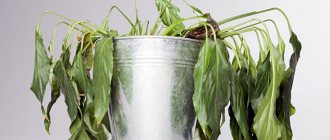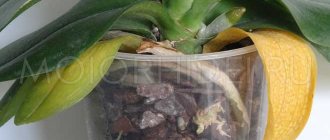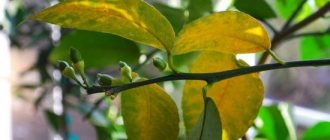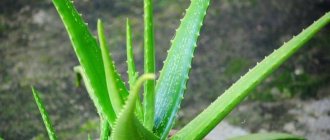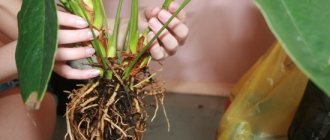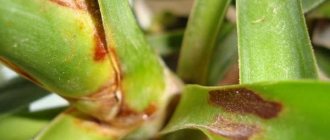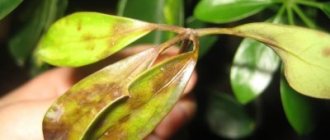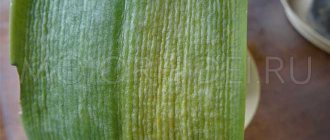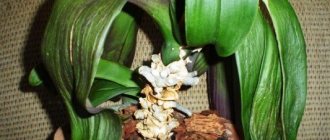Zamioculcas is an evergreen plant native to tropical Africa.
Dear readers!
For you, we have created communities on social networks in which useful articles and interesting ideas are published several times a day! Subscribe and receive useful content in a convenient format! This flower is popularly called the dollar tree. It is believed that if you plant zamioculcas at home, the owners will be guaranteed success in money.
The flower is not picky about its conditions and is easy to care for. But, like any other plant, zamioculcas can get sick or suffer from parasites. Among the most common problems are fungus, damage to the root system and yellowing of leaves.
Next, we will talk about why your zamioculcas got sick and how to help it.
Reasons related to leaving
The dollar tree is a hardy plant that can successfully resist many diseases and pests.
But sometimes the owner may notice how his pet’s leaves have begun to turn yellow. There are several reasons for this phenomenon.
First, let's look at the reasons related to flower care
Features of watering
Very often, dollar tree leaves turn yellow due to improper watering.
Zamioculcas does not like wet soil. In summer, the soil in the pot should dry out a little. It is also undesirable to have moisture in the pan. Therefore, if water has accumulated there after watering, it must be drained.
In spring and summer, the flower needs to be watered once every 7-10 days.
In winter, the dollar tree enters a dormant period. At this time of year it needs even less moisture. One watering per month will be enough.
Please note that you need to water the plant with water at room temperature. You should not use freshly drawn tap water for these purposes.
IMPORTANT!
If you are in doubt about whether to water Zamioculcas, it is better to wait 1-2 days. The flower will not dry out. It will be much worse if you “flood” it.
Wrong location of the flower
Location of Zamioculcas in the back of the room
Dollar Tree, being a native of Africa, loves bright light and warmth. Therefore, it is best to grow it on a south-facing window, and in summer take it out onto the balcony, veranda or yard.
But at the same time, the flower will not wither on the north side. It will just be a little smaller in size.
High humidity and low temperatures are very harmful for Zamioculcas. Such conditions of detention negatively affect the plant’s immunity.
Therefore, if the leaves of a flower begin to turn yellow, check its location. This is especially true for the cold season.
Drafts
It is highly undesirable to leave a dollar tree in a draft, especially in winter. If a warm summer breeze from an open window doesn’t do anything bad to the zamioculcas, then the winter draft causes the plant’s leaves to turn yellow and fall off. Dark spots appear on them. Young shoots are especially susceptible to this destructive process.
Sunburn
The dollar tree loves sunlight. But this does not mean that zamioculcas does not need to be protected from direct sunlight.
The plant can be exposed to the heat without harm only outside, where it is cooled by the movement of air masses. If you don’t take the flower out into the fresh air in the summer, then place it in the back of the room. This will protect your pet from harmful direct rays of the sun.
Prolonged exposure of the plant to the sun leads to burns, as the temperature of the leaves rises and cooling does not occur. As a result, they begin to turn yellow and then dry out completely.
Yellowing of zamioculcas leaves
Affected leaves need to be cut off at the root. But such pruning at the height of the season harms the appearance of Zamioculcas. The flower is slow-growing and is not able to restore green mass at a rapid pace.
If you do get burned, then you urgently need to rearrange the flower or shade the place where it is located. The leaves need to be treated with an adaptogen.
Frostbite
Zamioculcas leaves also turn yellow due to frostbite. This can happen, for example, if you ventilate a room in winter. And at the same time, the dollar tree stands under the open window. Or if in the fall a flower located in the open air was hit by the first frost.
In these cases, you need to remove the plant from the cold and treat the affected leaves.
Temperature changes
Zamioculcas withstands changes in ambient temperature. It feels good both at 12 degrees in winter and at 26 degrees in summer.
But keep in mind that the flower really does not like sudden changes in temperature. For example, if you decide to move the pot from the room to a cold balcony or corridor, the leaves of the plant will begin to turn yellow.
Therefore, to prevent your flower from suffering, provide it with a stable temperature regime.
Air humidity
The dollar tree is not picky about indoor air humidity and does not require spraying. But there is still no need to keep the plant in extreme conditions. And in too dry a climate, and with high humidity, the flower may feel unwell.
If the air in your apartment is too dry in winter, then wipe the leaves with a damp cloth. Sometimes you can spray the plant, but you shouldn’t overuse it.
IMPORTANT!
The most important rule for caring for zamioculcas is moderation. There is no need to arrange a survival quest for your green pet.
Prevention
Zamioculcas leaves turn yellow for various reasons, but in order to avoid deterioration of the plant’s condition, preventive measures should be taken during the care process.
- The transplantation procedure is carried out in the spring, before or at the initial stage of the growing season.
- After corrective pruning, the cut areas must be treated, which prevents infection.
- They contain the flower taking into account the recommended standards regarding the microclimate of the room.
- Newly acquired specimens are kept in quarantine for about 7-15 days.
- Observe the watering regime, especially in the cold season.
Natural aging
Another reason for yellowing of zamioculcas leaves is aging. It is easy to determine that yellowness appeared due to natural reasons. The dollar tree first gets rid of 2-3 yellowed leaves at the base of the branch. While at its end new leaf plates are formed. This is a natural process that indicates proper care of the plant.
You need to worry if the flower has slowed down its growth and does not want to renew its foliage. This indicates illness. This means we need to look for its cause.
Zamioculcas gets rid of old foliage
INTERESTING!
One cutting of Zamioculcas cannot have more than 17 leaves at the same time. Therefore, its old leaves periodically fall off. There is no need to be afraid of this if the plant looks healthy on the outside.
Softening tissue
Symptoms
Branches (compound leaves ) become soft at the base , leaf blades and thickened petioles rot .
Cause
The most common reason for this condition of the dollar tree is, again, a violation of the watering regime . Excessive watering, waterlogging of the soil and water standing in the pan are the main causes of the problem , especially if this happens indoors in winter at unfavorable temperatures (too cold or too warm).
soft black spots appear on the leaves (not to be confused with the natural “spotty” color of the petioles), then this also tells us about excessive watering.
marijana1 / Personal archive
Excess and lack of fertilizing
Like any living organism on the planet, zamioculcas needs proper and timely nutrition. A lack of nutrients leads to yellowing of the leaves, loss of appearance and general weakness of the plant.
The dollar tree accepts both organic and mineral fertilizers well. The ideal feeding scheme is to alternate types of fertilizer.
You can also do the fertilizing yourself. Professionals advise using sugar water, ground eggshells, yeast, citrus zest and banana peels as fertilizer.
The first time you need to feed a flower is when planting it in a pot. During the growing season, fertilizing should be done 2 times a month. When buds appear on the flower, feeding must be stopped until next spring.
Frequent fertilization is undesirable and can lead to plant disease.
Zamioculcas grows slowly, so excess feeding will only clog the soil and negatively affect the general condition of your pet.
IMPORTANT!
If you have “overfed” the plant, then you need to take the following measures:
- the flower must be removed from the pot;
- thoroughly clean from spoiled soil;
- check the roots of the plant;
- if there are damaged areas, remove them;
- transplant into another pot.
The plant has become thinner
The leaf blades have become thin , and the previously fleshy leaf petioles have become very wrinkled .
How long have you been watering the plant? If its leaf “bottles” have also shriveled, then, for sure, you have managed to dry even zamioculcas. The plant survived on its succulent properties and most likely gradually depleted its reserves of moisture , set aside for a rainy day.
- Resume watering , only a little and gradually . Soon the plant will fully recover.
Krzysztof Ziarnek, Kenraiz / Personal archive
Recent transplant
Transplanting Zamioculcas
Like any plant, Zamioculcas needs to be replanted into a larger pot from time to time. At first, the flower will simply settle into a new place and spend all its energy developing roots to fill the entire space with them.
To ensure a successful transplant, be extremely careful and try not to damage the plant tubers. Any wound can lead to rotting and yellowing of the foliage. Therefore, after removing the plant from the old pot, you need to carefully examine its roots for wounds and cuts.
If you accidentally injured a flower, the wound should be treated with cinnamon or charcoal powder. After treatment, the tubers should be exposed to air for a while so that the wounds heal. The dollar tree can then be planted in a new pot.
What to do if zamioculcas leaves turn yellow
No measures need to be taken if the leaves of zamioculcas turn yellow from old age. As well as removing the drying plates entirely - rachis is still involved in photosynthesis. To make the flower beautiful, like in the photo, you can simply rotate it relative to the viewing point.
How to fix watering errors
If the zamioculcas is overdried, the earthen lump is taken out of the pot, if necessary, the roots are stripped, and immersed in warm water for a few minutes. Then dry it on newspaper and return it to the container. Water next time in about a month.
The advice to gradually moisten the earthen ball is only suitable for slight drying of the substrate, but such a maintenance error usually goes unnoticed. When the rachis or tubers have shriveled and the leaves have turned yellow, you need to save the zamioculcas and not splash the surface of the substrate with water. Such watering is not able to saturate the plant with moisture - immersion is necessary.
With slight waterlogging, when you can get by with drying the earthen clod on paper that absorbs water well, the leaves of Zamioculcas do not turn yellow. They change color if the sucking shoots or tuber begin to rot.
Algorithm of actions:
- Take the plant out of the container.
- Shake off the old substrate.
- Clean rotten areas of roots to healthy tissue.
- Disinfect wound surfaces.
- Dry in partial shade with good air ventilation and a temperature of at least 20° C for 1-3 days. Nothing will happen to Zamioculcas during this time. But what you can’t do is plant it in fresh soil right away - the leaves will continue to turn yellow, and perhaps the flower will die.
- The pot is washed, treated with potassium permanganate, and new drainage is added (at least 1/4 of the container).
- Plant zamioculcas in fresh cactus soil.
- Water for the first time after a month.
If the root has rotted completely, but healthy leaves remain, they can be rooted. Otherwise, elastic segments taken from the middle part of the rachis are planted in perlite or light soil.
Root problems and damage
Roots are the most important part of Zamioculcas. Root disease can lead not only to yellowing of the leaves, but also to the death of the plant.
There are 2 main problems:
- rotting of the root system;
- tuber damage.
If your pet's roots begin to rot, then with a high degree of probability you have “flooded” it. Excess moisture causes fungus to appear in the soil, which causes rot.
In this case, zamioculcas must be completely cleared of old wet soil, treated with a systemic fungicide, sprinkled with activated carbon or ash and replanted in dry soil. The soil must first be disinfected by pouring boiling water on it or placing it in the microwave for a couple of minutes.
The other most common problem with Zamioculcas roots is damage to the tuber. Most often this happens during transplantation.
If you do not notice the wound in time, it may become infected from the soil. If the infection begins to spread throughout the tubers, then only pruning the infected part can help. The cut area must then be treated with ash or activated carbon.
Zamioculcas root system
Natural yellowing of foliage
Yellowing of old leaves and dying of branches with the constant growth of new stems are considered normal. If new growth does not appear and the leaves fade, the plant needs to be saved. If the damage is significant, the flower is rejuvenated: a green branch is cut off and placed in cold boiled water. When the stem takes root, it is planted in the prepared soil, after feeding it with fertilizers.
Old zamioculcas bush
When growing zamioculcas, you should follow simple care rules. Moderate watering, diffused light and light soil are all that an unpretentious flower needs. Even novice gardeners can care for the bush.
Diseases and pests
There are two types of diseases that Zamioculcas can be susceptible to:
- fungal infections (fusarium, late blight, anthocrosis);
- bacterial infections (wet rot, dry rot).
The dollar tree is rarely attacked by pests because its leaves are covered with a protective waxy coating.
Only scale insects, spider mites, aphids and mealybugs can cause real harm to the plant. It is these parasites that are able to overcome the protective layer of the flower.
If you notice pests, you need to take the following measures:
- isolate the diseased plant;
- cover the soil with foil;
- collect parasites with your hands;
- wrap the flower in alcohol-soaked cloth;
- treat the affected areas with soap or tobacco solution;
- wash the leaves with clean water;
- treat with insecticides.
Preventive measures
Biologists identify several preventive measures that will help avoid yellowing of leaves and grow a healthy and beautiful plant:
- maintaining the temperature in the room;
- implementation of regular and moderate watering;
- creating a comfortable level of illumination;
- timely application of nutrients;
- mandatory use of drainage materials;
- regular use of chemicals against pests and fungal diseases;
- using only light and loose nutrient soil;
- increase in air humidity in summer.
To prevent rotting of the root system, it is necessary to moisten the soil only after it has completely dried. A wooden stick lowered to the very bottom of the pot will help determine the level of soil drying. If, after removing it, the wooden surface remains completely dry, you can water it.
Every housewife wants to see in her flower garden not only traditional indoor plants, but also unusual flowers that can surprise not only family members, but also guests with their shapes, leaf structure and color scheme. An unusual plant with an amazing structure is the dollar tree. This flower will decorate any greenhouse, and if properly cared for, it will delight you with the appearance of a flower stalk.
Beginning flower growers should pay special attention to studying the rules of caring for an unusual representative of the Cactus family.
For information on how to transplant zamioculcas, see the video below.
Answers to frequently asked questions
Zamioculcas
Why does the plant rarely produce new foxes?
Zamioculcas is a slow growing plant. In addition, it takes a lot of energy to bloom.
Is it true that the dollar tree is poisonous?
Zamioculcas does contain some toxic substances. But they do not bring harm to humans. Moreover, the flower purifies the air in the apartment.
But we still do not recommend eating zamioculcas.
What does Zamioculcas need to grow?
Like any plant, zamioculcas first develops its roots and only then begins to grow. If your flower is not growing, you may have chosen the wrong size pot for it.
Also, keep in mind that active plant growth begins in the second half of summer and continues until early March.
How to propagate a dollar tree?
Zamioculcas can be propagated in any way: by dividing tubers, leaves, stems.
How soon will the transplanted plant produce its first shoots?
It is difficult to say exactly, since many factors need to be taken into account. The speed of germination depends on the volume of the pot, the time of year and the quality of the seedlings.
The main point of growing
Zamioculcas usually grows and develops without problems. This is one of the most unpretentious plants in the world. It is suitable for everyone , even the most inexperienced and novice flower growers. Zamioculcas should not be planted only by those gardeners who love to water their plants too much.
- The main reason for its poor health and death is precisely incorrect, excessive watering . regulates the amount of moisture for the time being , storing it in its leaves and tuberous rhizome, and then begins to “ signal .” If the plant is bad and it is dear to you, then it needs help .
Mokkie / Personal archive
How to grow roots in Zamioculcas. Methods for propagating Zamioculcas at home
21
Zamioculcas is a flower that will bring prosperity to the house, popularly called the dollar tree. How Zamioculcas reproduces at home, what conditions are needed for this, you can read or watch the video
. The main thing in reproduction is not to rush things; the development of roots takes more than one month. First, the plant gains a tuber, and only then begins to grow green mass. Each subsequent branch grows from a tuber that increases in size.
Breeding conditions
Caring for zamioculcas at home includes reproduction with periodic transplantation into a new container. In this case, the process of dividing the tubers is gentle. They need to be carefully planted in prepared bowls with a good drainage layer and covered from above until new leaves begin to form.
All parts of the plant are poisonous. When working, you need to use gloves, and ensure that pieces of the plant are not eaten by animals or children.
Other ways to obtain new plants would be to root cuttings, leaves or cut tubers. It must be taken into account that any method of reproduction takes a long time. Therefore, if germination occurs in water, then it should not turn sour. The substrate for germination does not contain humus, is sterile, steamed.
During the rooting process, a nodule is formed due to the nutrients of the leaf or cutting. Therefore, by the time the first young leaf appears, the old part turns yellow and wrinkles. This is fine.
Rooting occurs in warmth and light. To prevent the ground part from evaporating moisture, a cap is created over the plant, and sometimes the new plant is ventilated. Water very sparingly, so that the water wets the soil only near the walls of the cup.
How to plant zamioculcas at home
If a flower has outgrown its container and the gardener does not need new specimens, then the roots are not disturbed. The pot is either cut or broken, the plant is removed and planted in a new container, slightly larger than the previous one.
How to propagate Zamioculcas at home when planting an adult plant? Plant each tuber in a separate bowl. The soil taken is light and fertile. Add humus and expanded clay to the composition of equal parts:
- turf;
- leaf soil;
- sand;
- peat
The plant should only be planted in spring in shallow pots, a quarter of the height of which is occupied by the drainage layer.
For replanting, you can divide the bushes by carefully disassembling the intertwined roots, or you can cut the tuber. If there is more than one dormant bud on a tuber, it is divided in half. The sections are dried, sprinkled with coal dust, and planted in a small pot. You can water the soil for the first time after 3 days, a little.
Any replanting or handling of a flower is stressful, and it takes time for it to regain its healthy appearance. Therefore, the flower grows until it deforms the pot. If you plant zamioculcas in a large container until it is full, there will be no growth of branches.
Propagation of Zamioculcas by cuttings and leaves
As practice shows, it is easier to propagate zamioculcas from leaves or cuttings. To do this, you do not need to injure the plant by replanting. With a sharp knife you can separate one pinnately dissected stem. If it is cut into segments that have growth buds, then these are cuttings. The top cutting may contain many leaf blades. And the higher the cutting, the more successful the rooting.
At home, Zamioculcas reproduces both in water and in a special substrate. It is important that the tip of the petiole does not rot. To do this, activated carbon or a fungicide is added to the water to suppress the rotting process. It takes a month or more before roots appear. Rooting can also be done in clean, damp sand or sphagnum moss.
Leaf blades for propagation are cut with a sterile instrument with a piece of stem. They can take root in water or directly in a sterilized substrate. This rooting will last 2-6 months, you need to be patient while the nodules grow at the base of the leaf.
If you plant the top part of the leaf with several leaf blades, development will be faster. But then each leaf must be planted in a separate glass and a support must be provided. The dishes must have a drainage layer and a hole for draining water. The cuttings are placed in a sealed bag or under a jar. Occasionally, the plant is ventilated, watered sparingly, along the walls of the vessel. And only when the first leaf appears, the cover is removed.
Part 1.
Part 2.
Part 3.
Part 4.
Excess fertilizer
Don’t be surprised, but another reason why zamioculcas leaves turn yellow or darken may be an excess of nutrients in the soil. Feed the plant with fertilizers for ornamental foliage plants, but make the concentration twice as weak as the manufacturer advises.
Now you know the 7 main reasons for the yellowing of leaves on a dollar tree and what to do, how to save Zamioculcas if the leaves on it still turn yellow, dry out, and rot. Be sure to follow the link at the top of the article and carefully read how to properly care for a bucks tree at home.
Reviews from flower growers: no sooner had he appeared than he became everyone’s favorite
As soon as I first saw Zamioculcas in the store, I stopped sleeping and eating. Big, beautiful and shiny! But the price of the flower was so immodest that I was afraid for my budget.
I recently planted my “castle” and discovered the following: I watered it once a week, and during replanting I had to cut off a lot of rotten roots and remove one “potato” that had rotted from excess moisture. Now I will definitely water it once every 2 weeks.
To everyone who is afraid to start the lock because of the light: yes, it loves a lot of light, but I want to share my experience: it is on the north window (there is never any sun). I took it out onto the balcony for the whole summer, where there is never any sun either. He fired 5 huge arrows, as thick as a baby’s hand and up to 60 cm long. That’s it. So don't be discouraged girls
I can tell you the right way to quickly grow this plant. Per liter of water Epin and Kornevin - and pour. So water it in a week, 3 times. And you will see for yourself what will happen! Good luck! By the way, this is how I water all my plants. Very good results!
Zamioculcas is a plant that is distinguished by its unpretentious disposition and good health. But it can also be undermined if you do not take into account the characteristics and needs of the flower. Overmoistening of the soil is especially harmful for it. Due to frequent watering, the most vulnerable part - the tuberous root - may suffer. However, in this case, Zamioculcas confirms its reputation as a strong plant. A skilled florist will be able to cope with its resuscitation. But it is better not to take it to extremes, but to follow the rules of care. Then Zamioculcas will always be healthy.
- Author: Natalya Sokolova
I am a philologist by training. My hobbies are reading, traveling, caring for the garden and pets. Therefore, much of what I write about is not theory at all, but practice, personally experienced. Rate this article: (18 votes, average: 4.2 out of 5)
